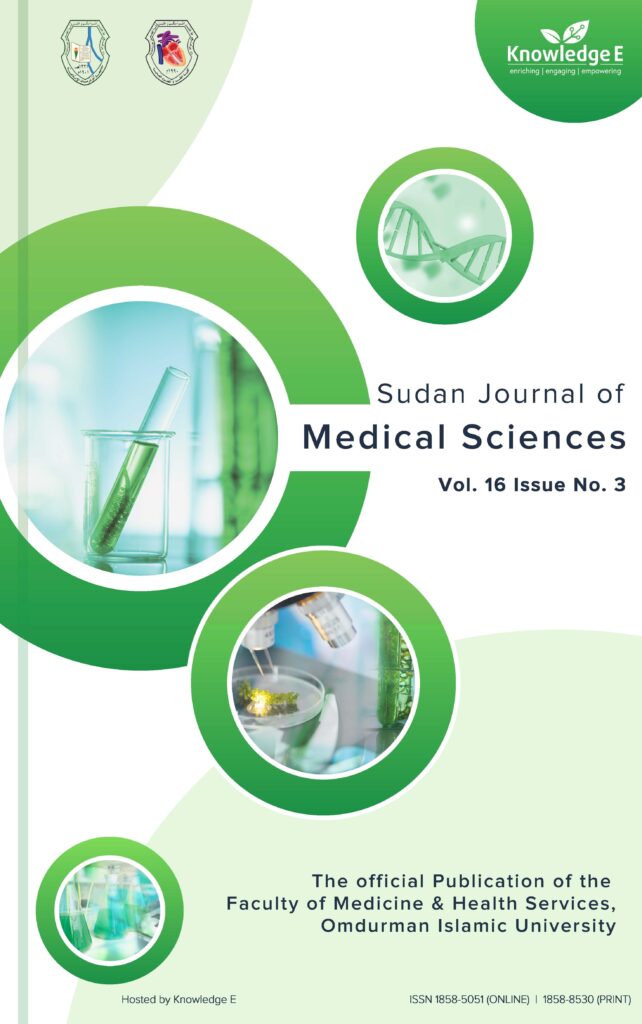
Sudan Journal of Medical Sciences
ISSN: 1858-5051
High-impact research on the latest developments in medicine and healthcare across MENA and Africa
Frequency of Insulin Resistance in People with Thyroid Dysfunction
Published date:Dec 14 2021
Journal Title: Sudan Journal of Medical Sciences
Issue title: Sudan JMS: Volume 16 (2021), Issue No. 4
Pages:531 - 539
Authors:
Abstract:
Background: Thyroid dysfunction is an endocrine disorder with a recognized association with type 2 diabetes mellitus. Thyroid hormones have a remarkable effect on glucose metabolism and can cause insulin resistance (IR). This study was aimed at assessing the relationship between IR and thyroid dysfunction.
Methods: This case–control study was conducted at the endocrinology outpatient clinics of Ibrahim Malik Hospital and Omdurman Military Hospital in Khartoum State, Sudan between May 2018 and January 2019. Fasting blood glucose (FBG), fasting insulin level, and thyroid function test (TFT) were measured for each candidate and IR was estimated using the HOMA-IR equation.
Results: Thirty-one patients with thyroid dysfunction and fifty-seven control participants were enrolled. The highest mean FBG was found among cases (105.3 ± 15.7 mg/dl) compared to the controls (97 ± 12.1 mg/dl), but the difference was not statistically significant (P-value = 0.598). The mean fasting insulin level was 9.22 ± 4 IU/ml in the cases and 9.4 ± 4.2 IU/ml in controls, without a significant difference (P-value = 0.681). The highest HOMA-IR score was found among cases (2.4 ± 1.2). It was 2.4 ± 1.3 in hyperthyroidism, 2.3 ± 1.1 in hypothyroidism, and 2.4 ± 1.2 in controls, and the difference was insignificant (P-value = 0.859). IR was higher in the cases (58.1%) compared to the controls (52.6%) but again not statistically significant (P-value = 0.396). Among cases, IR was encountered in 61.9% and 50% of hyperthyroid and hypothyroid patients, respectively.
Conclusion: Patients with thyroid dysfunction have some level of IR that was not statistically significant when compared with controls.
Keywords: thyroid dysfunction, insulin resistance, type 2 diabetes mellitus
References:
[1] Medani, A. M. M., Elnour, A. A., and Saeed, A. M. (2011). Endemic goitre in the Sudan despite long-standing programmes for the control of iodine deficiency disorders. Bulletin of the World Health Organization, vol. 89, no. 2, pp.121–126.
[2] Perros, P., McCrimmon, R. J., Shaw, G., et al. (1995). Frequency of thyroid dysfunction in diabetic patients: value of annual screening. Diabetic Medicine, vol. 12, no. 7, pp. 622–627.
[3] Hall, J. E. (2016). Guyton and Hall Textbook of Medical Physiology (13th ed.). Available at: https://dokumen.pub/guyton-and-hall-textbook-of-medical-physiology-13nbsped.html (Accessed 2021 April 28).
[4] Wang, C. (2013). The relationship between type 2 diabetes mellitus and related thyroid diseases. Journal of Diabetes Research, vol. 2013, p. 390534.
[5] Brenta, G. (2011). Why can insulin resistance be a natural consequence of thyroid dysfunction? Journal of Thyroid Research, vol. 2011, article 152850.
[6] Einhorn, D., Reaven, G. M., Cobin, R. H., et al. (2003). American College of Endocrinology position statement on the insulin resistance syndrome. Endocrine Practice: Official Journal of the American College of Endocrinology and the American Association of Clinical Endocrinologists, vol. 9, no. 3, pp. 237–252.
[7] Ohguni, S., Notsu, K., and Kato, Y. (1995). Correlation of plasma free thyroxine levels with insulin sensitivity and metabolic clearance rate of insulin in patients with hyperthyroid Graves’ disease. Internal Medicine, vol. 34, no. 5, pp. 339–341.
[8] Maratou, E., Hadjidakis, D. J., Peppa, M., et al. (2010). Studies of insulin resistance in patients with clinical and subclinical hyperthyroidism. European Journal of Endocrinology, vol. 163, no. 4, pp. 625–630.
[9] Purohit, P. (2012). Estimation of serum insulin, Homeostasis model assessment-insulin resistance and C-peptide can help identify possible cardiovascular disease risk in thyroid disorder patients. Indian Journal of Endocrinology and Metabolism, vol. 16, no. 1, pp. S97–S103.
[10] Al Sayed, A., Al Ali, N., Bo Abbas, Y., et al. (2006). Subclinical hypothyroidism is associated with early insulin resistance in Kuwaiti women. Endocrine Journal, vol. 53, no. 5, pp. 653–657.
[11] Tuzcu, A., Bahceci, M., Gokalp, D., et al. (2005). Subclinical hypothyroidism may be associated with elevated high-sensitive c-reactive protein (low grade inflammation) and fasting hyperinsulinemia. Endocrine Journal, vol. 52, no. 1, pp. 89–94.
[12] Maratou, E., Hadjidakis, D. J., Kollias, A., et al. (2009). Studies of insulin resistance in patients with clinical and subclinical hypothyroidism. European Journal of Endocrinology, vol. 160, no. 5, pp. 785–790.
[13] Kapadia, K. B., Bhatt, P. A., and Shah, J. S. (2012). Association between altered thyroid state and insulin resistance. Journal of Pharmacology & Pharmacotherapeutics, vol. 3, no. 2, pp. 156–160.
[14] Vyakaranam, S., Vanaparthy, S., Nori, S., et al. (2014). Study of insulin resistance in subclinical hypothyroidism. International Journal of Health Sciences and Research, vol. 4, no. 9, pp. 147–153.
[15] Singh, B. M., Goswami, B., and Mallika, V. (2010). Association between insulin resistance and hypothyroidism in females attending a tertiary care hospital. Indian Journal of Clinical Biochemistry, vol. 25, no. 2, pp. 141–145.